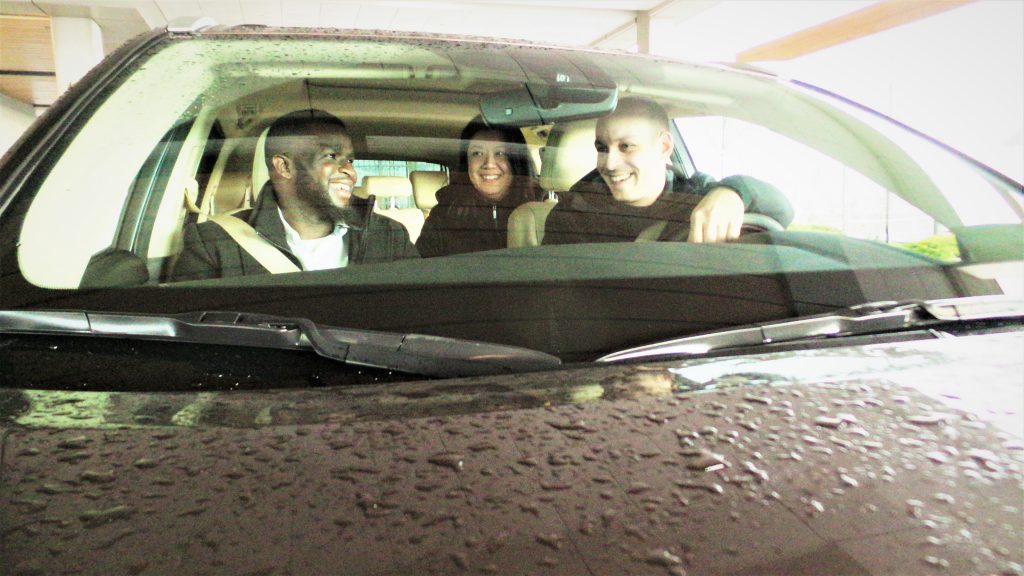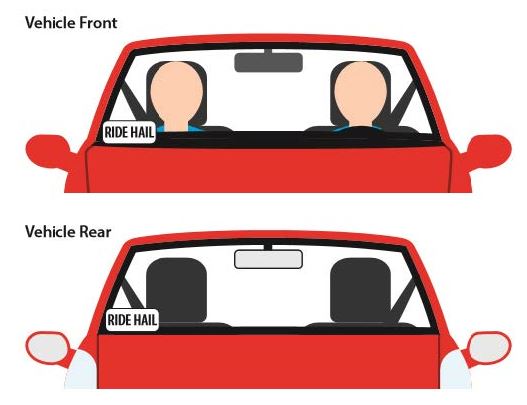
Ride-hailing isn’t straightforward, so here’s our simplified take on the topic, to show you how passenger transportation regulations help ensure a safe ride in BC.
What is Ride Hailing?
Ride-hailing is an arrangement where for-profit, taxi-like services are provided by private drivers, using technology like smartphone apps.
GPS is used to connect drivers with people seeking transportation, and payment is made online.
Unlike taxis, ride-hail vehicles cannot be flagged down on the street, can only accept payment through the app, and generally set fees when the booking is confirmed.
When Did it Start in BC, Who Was Involved?
The first ride-hailing licence was approved in BC by the Passenger Transportation Board in December 2019.
Ride-hailing has been operating for several years in other jurisdictions in Canada and in other parts of the world. When considering ride-hailing for BC, there were factors to analyze to ensure our province didn’t encounter the traffic congestion and safety issues of jurisdictions where ride-hailing was largely unregulated.
To look at all the angles, we engaged extensively with stakeholders throughout the province. We connected with the taxi and limousine industry, local governments, business associations, accessibility groups and ride-hail companies to present ideas and gather feedback. Along the way, improvements were made to help the taxi industry modernize and remain competitive alongside these new services. Taxi licensees were allowed, for example, to increase their fleet size by up to 15 per cent to put more vehicles on the road.
Ultimately, changes were made to regulations for all passenger-directed vehicles (a fancy way of talking about ride-hail, taxi or limousine services) to help ensure passenger safety, protect consumers and provide a reliable and stable business environment.

The Whys of BC Passenger Transportation Act Ride-Hail Regulations
While the lower costs of commercial ride hailing might be attractive to consumers (who doesn’t like a deal?) or companies wanting to do more business (potential to increase earnings!) or individuals looking to make a little extra money, provincial passenger transportation regulations are there for good reasons. Here’s what’s required and why:
- Any vehicle operated by a person or company that is paid for transporting passengers must be licenced by the Passenger Transportation Branch.
WHY: Oversight of the commercial passenger transportation industry creates a stable, reliable market for businesses and consumers, and ensures safety for passengers. - Taxis, limousines, ride-hail vehicles and other small passenger-directed services must be approved by the Passenger Transportation Board.
WHY: to ensure that transportation services are available to all members of the public and supporting accessibility, and that operators are fit and capable of providing the service. - Fares charged by taxis, limousines, ride-hail and other small passenger-directed vehicles are set or approved by the Passenger Transportation Board.
WHY: to ensure a stable operating environment for business, and reasonable prices for consumers. This protects passengers and transportation companies from overcharging or under-cutting (which could affect safety or quality). - A National Safety Code Certificate
WHY: to ensure that companies meet or exceed common safety standards for their drivers and vehicles. - Commercial vehicle inspections performed annually or semi-annually depending on vehicle usage.
WHY: to ensure vehicles are mechanically safe and sound. - Clearance from the municipality where they plan to operate.
WHY: to ensure operators are authorized to serve a geographic area and will respect bylaws. - Driver screening. Drivers of commercial passenger directed vehicles must:
– Pass a police information check that screens for past convictions of violent or sexual offences as well as other offences
– Undergo a driving record check that screens out those with unsafe behaviour
– Get a commercial driver’s licence
WHY: to ensure the driver is qualified to operate a vehicle of this nature and meet the higher driver medical requirements.
- ICBC vehicle insurance specific to ride-hail.
WHY: to ensure that passengers are covered in event of damage or injury to them or their belongings, should there be a collision. This also ensures drivers are covered by insurance based on how they use their vehicle – personal use insurance may be void if the driver gets into a crash while transporting paying passengers.
How are Regulations Enforced?
Companies or individuals that don’t meet the requirements can be fined for advertising or providing a commercial passenger transportation service. The police, Commercial Vehicle Safety and Enforcement officers and Passenger Transportation Enforcement Officers can issue tickets for $1,150, at roadside. Repeat offenders may be fined up to $5,000. Licensed operators could be fined up to $50,000 for administrative penalties.
An example an administrative penalty would be if a ride-hail company didn’t have all their documentation ducks in a row, meaning they didn’t have a paper trail demonstrating they had screened their drivers appropriately given the guidelines above. Failure to screen drivers properly could result in an administrative penalty.
And you may be wondering about illegal operators, because there are some, especially in the Lower Mainland. Well, these illegal operators can now be charged $100,000 per day. That might seem steep, but given the safety risk to passengers (as demonstrated through various lawsuits around the world right now against ride-hail companies), companies that don’t want to do their part to ensure passenger safety need to feel the consequences.
Passenger Tips
Do your research to ensure the ride-hail company you’re booking with is a licensed operator.
Know how to identify a ride-hail vehicle when it picks you up? Look at the licence plate of the vehicle and make sure the number on the plate matches the description given to you in the app.
Drivers are also required to have the company logo as either a sticker or decal on both the front and rear windshield.
Check out the information for passengers web page for more.

Hopefully, this explanation of how ride-hail business operates has shed some light on some of your questions, so that as a passenger you’re not taken for an (unsafe) ride. And, if you’re a driver or operator, we hope you now understand the consequences of failing to follow passenger transportation regulations.
For more about ride-hail services visit the Passenger Transportation branch website.
We also have a blog about licensing for people offering or considering offering any kind of a commercial passenger service.
Hello,
Is there any government contact responsible for taking in complaints for ride hailers?
Thanks
Hello John Doe – thanks for your comment. The Passenger Transportation Branch is responsible for enforcement. You can read more about that and contact them through this link: https://www2.gov.bc.ca/gov/content/transportation/vehicle-safety-enforcement/services/passenger-transportation/compliance-enforcement
So Ride Hale vehicles, HOW does one get a RH?
All RHs are the same colour or are they tagged to the various taxi business colours?
What jurisdictions do they operate in?
Hi Collin,
This blog provides an overall look at ride-hailing — what it is, how to do it, and why it’s important to be sure you’re travelling with a licenced ride-hail company: https://www.tranbc.ca/2020/01/23/everything-you-wanted-to-know-about-ride-hailing-in-bc/
Here is the list of licenced ride-hail companies operating in various areas: https://www2.gov.bc.ca/gov/content/transportation/vehicle-safety-enforcement/services/passenger-transportation/guidance-resources/passenger-transportation-registry#licencedridehail
When you are being picked up by a ride-hail, look at the licence plate of the vehicle and make sure the number on the plate matches the description given to you in the app. Drivers are also required to have the company logo as either a sticker or decal on both the front and rear windshield. More tips for passengers taking ride-hail vehicles: https://www2.gov.bc.ca/gov/content/transportation/vehicle-safety-enforcement/services/passenger-transportation/transportation-network-services/ride-hailing-info-passengers
one of the ways that app-based passenger directed transportation companies could help address the climate emergency is to make sharing rides that are already going in a direction to be used for folks who aren’t driving. Making everyone a potential taxi-type ride is a way to do this and provide the necessary incentives.
Unfortunately, the regulations developed would seem to me to undercut that incentive for folks. Most people are not going to get a commercial lisence and proper insurance unless they will be driving around a bunch for profit.
Perhaps we could make an additional category for folks accepting a lower fee, and only taking rides that are going roughly where they are?
Hi Max,
Great question. We’ve sent it to our folks responsible and will let you know what we hear back.
Hello again Max,
Here’s what we heard back. The Passenger Transportation Branch does no regulate carpool vehicles. and the Passenger Transportation Act (PTA) and the Passenger Transportation Regulation (PTR) do not apply to carpool vehicles. However, the PTR outlines certain criteria that carpool vehicles must meet, to ensure proper distinction between carpool and Passenger Directed Vehicles (e.g. Taxi) or Transportation Network Services (e.g. Uber):
a) the vehicle accommodates a driver and up to 11 passengers;
b) the motor vehicle is used for no purpose other than to transport passengers on one return trip between the driver or passenger’s residence(s) and employment or other common destination
c) neither the driver nor the operator receives any compensation for the trip other than contributions for operating costs. Operating costs are limited to gas, tolls, ferry fares, insurance and maintenance costs. The total contribution for operating costs from all passengers must not exceed the operating costs that are attributable to the particular carpool trip.
• The PTB regulates Passenger Directed Vehicles (e.g. Taxi) or Transportation Network Services (e.g. Uber), and the PTA and PTR applies to both services
In other words: The PTA and PTR are not meant to undercut incentive for carpooling, the nature of the type of ride sharing (carpooling as defined in the criteria) mentioned in the blog post is allowed, therefore an additional category is not needed. Rather, operators of passenger vehicles would need to meet the criteria as outlined.
We hope that this information is helpful!
Come in if you’re not a coward!
Hi Chris – we’re not sure what you mean?
Ride-hailing is a terrible idea. It cannibalizes transit, puts more cars on the road, reduces safety, creates congestion and pollution, exploits drivers and the companies lose billions of dollars.
Hi Neil – thanks for your comment. We are sorry to hear your concerns and have shared them with the program area for review.